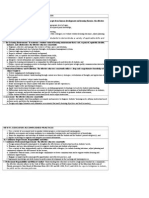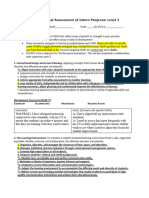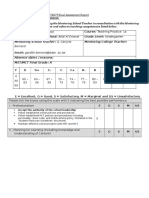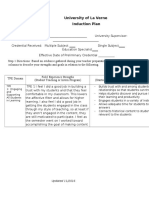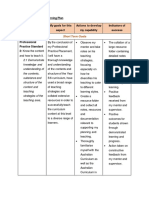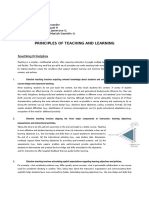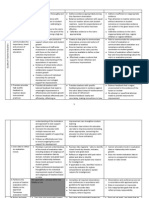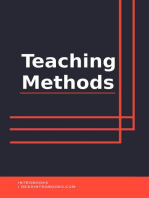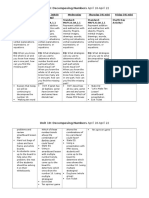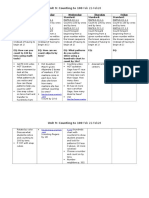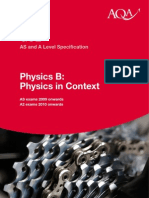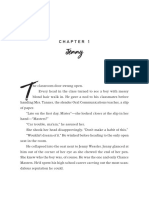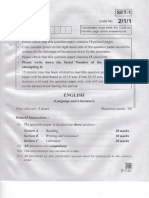0 ratings0% found this document useful (0 votes)
125 viewsMid-Term Goal Setting Update
Mid-Term Goal Setting Update
Uploaded by
api-210339745This document contains a mid-semester goal setting evaluation and rubric for an elementary education intern. The intern's goals are to more effectively differentiate instruction and collect assessment data more efficiently. For differentiating instruction, the intern teaches students in two groups and is working on assessing student data to further differentiate. For assessments, the intern is working on taking notes during lessons to better assess students. Feedback from the collaborating teacher encourages differentiating "in the moment" and grading assessments herself. The intern's next steps are to assess collected data and ask for past data to inform instruction. A new goal of improving classroom management is also discussed.
Copyright:
© All Rights Reserved
Available Formats
Download as DOCX, PDF, TXT or read online from Scribd
Mid-Term Goal Setting Update
Mid-Term Goal Setting Update
Uploaded by
api-2103397450 ratings0% found this document useful (0 votes)
125 views5 pagesThis document contains a mid-semester goal setting evaluation and rubric for an elementary education intern. The intern's goals are to more effectively differentiate instruction and collect assessment data more efficiently. For differentiating instruction, the intern teaches students in two groups and is working on assessing student data to further differentiate. For assessments, the intern is working on taking notes during lessons to better assess students. Feedback from the collaborating teacher encourages differentiating "in the moment" and grading assessments herself. The intern's next steps are to assess collected data and ask for past data to inform instruction. A new goal of improving classroom management is also discussed.
Original Title
mid-term goal setting update
Copyright
© © All Rights Reserved
Available Formats
DOCX, PDF, TXT or read online from Scribd
Share this document
Did you find this document useful?
Is this content inappropriate?
This document contains a mid-semester goal setting evaluation and rubric for an elementary education intern. The intern's goals are to more effectively differentiate instruction and collect assessment data more efficiently. For differentiating instruction, the intern teaches students in two groups and is working on assessing student data to further differentiate. For assessments, the intern is working on taking notes during lessons to better assess students. Feedback from the collaborating teacher encourages differentiating "in the moment" and grading assessments herself. The intern's next steps are to assess collected data and ask for past data to inform instruction. A new goal of improving classroom management is also discussed.
Copyright:
© All Rights Reserved
Available Formats
Download as DOCX, PDF, TXT or read online from Scribd
Download as docx, pdf, or txt
0 ratings0% found this document useful (0 votes)
125 views5 pagesMid-Term Goal Setting Update
Mid-Term Goal Setting Update
Uploaded by
api-210339745This document contains a mid-semester goal setting evaluation and rubric for an elementary education intern. The intern's goals are to more effectively differentiate instruction and collect assessment data more efficiently. For differentiating instruction, the intern teaches students in two groups and is working on assessing student data to further differentiate. For assessments, the intern is working on taking notes during lessons to better assess students. Feedback from the collaborating teacher encourages differentiating "in the moment" and grading assessments herself. The intern's next steps are to assess collected data and ask for past data to inform instruction. A new goal of improving classroom management is also discussed.
Copyright:
© All Rights Reserved
Available Formats
Download as DOCX, PDF, TXT or read online from Scribd
Download as docx, pdf, or txt
You are on page 1of 5
Goal Setting Evaluation and RubricMid Semester
What is the goal or
challenge to be met? To
which FEAP does this
goal/challenge apply?
What have you already
done to meet this goal
or challenge?
How can I more effectively
differentiate instruction?
When teaching, I usually
teach the class in two
groups. The groups are
divided by overall
academic and behavioral
progress. I am becoming
more able to differentiate
instruction between the
two groups such as asking
additional higher level
thinking questions or
providing additional
scaffolding when needed.
Even though the groups
differ a little, I am often
able to use data from the
first group to change my
instruction for the second
group to improve
effectiveness of the lesson.
How can I collect
assessment data more
efficiently?
3. Instructional Delivery and
Facilitation. The effective
educator consistently utilizes a
deep and comprehensive
knowledge of the subject taught
to: h. Differentiate instruction
based on an assessment of
student learning needs and
recognition of individual
differences in students;
4. Assessment. The effective
educator consistently:
a. Analyzes and applies data from
multiple assessments and
measures to diagnose students
learning needs, informs
instruction based on those needs,
and drives the learning process;
My CT pushes me to take
as many notes as possible,
especially when teaching
the lesson. This has shown
to be more difficult than
expected and requires a
strong ability to multi-task.
When teaching guided
reading groups, I have
started to take more notes
that will help assess for the
next meeting. This has also
helped me to differentiate
USF Elementary Education
What feedback related
to this goal or challenge
have you been given by
your Collaborating
Teacher and University
Supervisor?
With such a big class, she
said she often
differentiates instruction
in the moment based off
what she already knows
about the student.
She complements my
differentiation, especially
when rotating between
groups.
Usually when an
assessment is in the form
of an assignment, I have
just given her the
assignment papers and
that is the last time I see
them. Lately, she has been
encouraging me to grade
them myself instead of
giving them to her first.
This has helped me see the
students learning much
better than just observing.
I still struggle with taking
notes during a lesson, so
she reminds me often to do
so.
What are your next
steps? Include an
explanation of a
timeline for taking
those steps. If your goal
or challenge has been
met, this may include a
new goal or challenge.
I still need to work on
assessing my data that I
have collected during a
lesson. I also would like to
start asking my CT for past
data, especially when
related to a lesson, that
way I am able to teach
according to my students
needs.
Even though there is still
much work to do for my
goal, I believe that a
change of goal is necessary
after discussions with my
Supervisor. I have thought
that my classroom
management skills were
decent at this point in my
internship. Every day is
different, and I have found
it challenging to manage
the classroom when
students become very
active or emotional. Simple
things such as having a
substitute or a guest can
sometimes have an effect
Goal Setting Evaluation and RubricMid Semester
USF Elementary Education
my instruction during
reading lessons with these
students
on their behavior. I would
like to have a discussion
with my CT about new
strategies I could
implement or talk to my
Supervisor about additional
recommendations.
In what ways have you
collaborated with your
teacher to reach this
goal or challenge?
In what ways have you
taken that feedback into
consideration?
When discussing a lesson
that I will be teaching the
following week, we talk
about where the students
are (in relation to the
subject) This will also
include important
background information
needed when teaching a
new topic.
My CT always gives me
wonderful advice and
meaningful feedback. I
always at least try every
strategy/technique that she
provides. Since I have been
struggling to take notes
during a lesson, I will try
modifying her advice by
taking notes after a lesson.
Goal Setting Evaluation and RubricMid Semester
What evidence do you have that supports your
process of meeting this goal or challenge?
USF Elementary Education
Goal Setting Evaluation and RubricMid Semester
USF Elementary Education
NEW FL EDUCATOR ACCOMPLISHED PRACTICES
(a) Quality of Instruction.
1. Instructional Design and Lesson Planning. Applying concepts from human development and learning theories, the effective
educator consistently:
a. Aligns instruction with state-adopted standards at the appropriate level of rigor;
b. Sequences lessons and concepts to ensure coherence and required prior knowledge;
c. Designs instruction for students to achieve mastery;
d. Selects appropriate formative assessments to monitor learning;
e. uses variety of data, independently and in collaboration with colleagues, to evaluate student learning outcomes, adjust planning
and continuously improve the effectiveness of lessons.
f. Develops learning experiences that require students to demonstrate a variety of applicable skills and
competencies
2. The Learning Environment. To maintain a student-centered learning environment that is safe, organized, equitable, flexible,
inclusive, and collaborative, the effective educator consistently:
a. Organizes, allocates, and manages the resources of time, space, and attention;
b. Manages individual and class behaviors through a well-planned management system;
c. Conveys high expectations to all students;
d. Respects students cultural and family background;
e. Models clear, acceptable oral and written communication skills;
f. Maintains a climate of openness, inquiry, fairness and support;
g. Integrates current information and communication technologies;
h. Adapts the learning environment to accommodate the differing needs and diversity of students; and
i. Utilizes current and emerging assistive technologies that enable students to participate in high-quality communication interactions
and achieve their educational goals.
3. Instructional Delivery and Facilitation. The effective educator consistently utilizes a deep and comprehensive knowledge of the
subject taught to:
a. Deliver engaging and challenging lessons;
b. Deepen and enrich students understanding through content area literacy strategies, verbalization of thought, and application of the
subject matter;
c. Identify gaps in students subject matter knowledge;
d. Modify instruction to respond to preconceptions or misconceptions;
e. Relate and integrate the subject matter with other disciplines and life experiences;
f. Employ higher-order questioning techniques;
g. Apply varied instructional strategies and resources, including appropriate technology, to teach for student understanding;
h. Differentiate instruction based on an assessment of student learning needs and recognition of individual differences in students;
i. Support, encourage, and provide immediate and specific feedback to students to promote student achievement;
j. Utilize student feedback to monitor instructional needs and to adjust instruction.
4. Assessment. The effective educator consistently:
a. Analyzes and applies data from multiple assessments and measures to diagnose students learning needs, informs instruction based
on those needs, and drives the learning process;
b. Designs and aligns formative and summative assessments that match learning objectives and lead to mastery;
c. Uses a variety of assessment tools to monitor student progress, achievement and learning gains;
d. Modifies assessments and testing conditions to accommodate learning styles and varying levels of knowledge;
Goal Setting Evaluation and RubricMid Semester
USF Elementary Education
NEW FL EDUCATOR ACCOMPLISHED PRACTICES
e. Shares the importance and outcomes of student assessment data with the student and the students parent/caregiver(s); and
f. Applies technology to organize and integrate assessment information.
(b) Continuous Improvement, Responsibility and Ethics.
5. Continuous Professional Improvement. The effective educator consistently:
a. Designs purposeful professional goals to strengthen the effectiveness of instruction based on students needs;
b. Examines and uses data-informed research to improve instruction and student achievement;
c. Uses a variety of data, independently, and in collaboration with colleagues, to evaluate learning outcomes, adjust planning and
continuously improve the effectiveness of the lessons;
d. Collaborates with the home, school and larger communities to foster communication and to support student learning and
continuous improvement;
e. Engages in targeted professional growth opportunities and reflective practices; and
f. Implements knowledge and skills learned in professional development in the teaching and learning process.
6. Professional Responsibility and Ethical Conduct. Understanding that educators are held to a high moral standard in a community,
the effective educator adheres to the Code of Ethics and the Principles of Professional Conduct of the Education Profession of
Florida, pursuant to State Board of Education Rules 6B-1.001 and 6B-1.006, F.A.C, and fulfills the expected obligations to students,
the public and the education profession.
You might also like
- Key Selection Criteria 1 - 5 Luke PrengaDocument6 pagesKey Selection Criteria 1 - 5 Luke Prengaapi-3329320120% (1)
- Syllabus of The Sarawak Civil Service Six (6) Shared ValuesDocument10 pagesSyllabus of The Sarawak Civil Service Six (6) Shared ValuesNBH100% (3)
- Woodcock-Johnson III ExampleDocument24 pagesWoodcock-Johnson III Exampleapi-253754657100% (1)
- My Globalization StoryDocument2 pagesMy Globalization StoryLouise ArlosNo ratings yet
- FEAPs PortfolioDocument2 pagesFEAPs Portfoliochelsea2310No ratings yet
- Feap 4 WeeblyDocument3 pagesFeap 4 Weeblyapi-531495599No ratings yet
- FEAPs PortfolioDocument3 pagesFEAPs Portfoliochelsea2310No ratings yet
- Ow Commencement SpeechDocument2 pagesOw Commencement Speechapi-480429127No ratings yet
- Fear of Being AloneDocument28 pagesFear of Being AloneHà Anh Lê VũNo ratings yet
- NFDN 2006 CompetencyDocument4 pagesNFDN 2006 Competencyapi-317589937No ratings yet
- EXAMPLEPreschool Speech-Language AssessmentDocument10 pagesEXAMPLEPreschool Speech-Language AssessmentMohamed Elgendy100% (1)
- Long Term Development in Swimming (Australia)Document11 pagesLong Term Development in Swimming (Australia)Clubear Clubear100% (1)
- Mid-Term Goal Setting UpdateDocument4 pagesMid-Term Goal Setting Updateapi-276162957No ratings yet
- Final Feaps 3 CrawfordDocument2 pagesFinal Feaps 3 Crawfordapi-263387309No ratings yet
- Final Assessment HopkinsDocument6 pagesFinal Assessment Hopkinsapi-530094823No ratings yet
- KSC For PortflioDocument5 pagesKSC For Portflioapi-239660613No ratings yet
- FeapsDocument2 pagesFeapsapi-294525510No ratings yet
- Final Mid-Term ConferenceDocument5 pagesFinal Mid-Term Conferenceapi-330499669No ratings yet
- Feaps Portfolio IndicatorsDocument2 pagesFeaps Portfolio Indicatorsapi-272520734No ratings yet
- TPGP FinalDocument4 pagesTPGP Finalapi-267136890No ratings yet
- Module 1 Basic Concepts and Principles in Assessing LearningDocument5 pagesModule 1 Basic Concepts and Principles in Assessing LearningLeth JoseNo ratings yet
- Intern Midterm ConferenceDocument5 pagesIntern Midterm Conferenceapi-662674610No ratings yet
- Characteristics of Highly Effective Teaching and Learning (CHETL)Document4 pagesCharacteristics of Highly Effective Teaching and Learning (CHETL)Liezel Sanchez100% (1)
- Thuraya MST Final Mark Bas1Document3 pagesThuraya MST Final Mark Bas1api-316666989No ratings yet
- Instructional DecisionDocument13 pagesInstructional DecisionGlennson LoyolaNo ratings yet
- Module e pt27s2013-1428129Document25 pagesModule e pt27s2013-1428129api-235755026No ratings yet
- Day 5 Eman LCT AssessmentDocument84 pagesDay 5 Eman LCT AssessmentMiyNo ratings yet
- Goal Setting Evaluation and Rubric USF Elementary EducationDocument4 pagesGoal Setting Evaluation and Rubric USF Elementary Educationchelsea2310No ratings yet
- ASSESSMENT IN LEARNINGDocument3 pagesASSESSMENT IN LEARNINGcruzroxanmariem14No ratings yet
- CV ALI Math Teacher 2023-2024Document7 pagesCV ALI Math Teacher 2023-2024AliNo ratings yet
- Assessment in Learning FinalDocument7 pagesAssessment in Learning FinalJEZIEL BALANo ratings yet
- 2014 Teacher Summative Performance ReportDocument4 pages2014 Teacher Summative Performance Reportapi-215898557No ratings yet
- City University of Pasay College of Education Assessment of Learning Module 3 Formative and Summative AssessmentDocument4 pagesCity University of Pasay College of Education Assessment of Learning Module 3 Formative and Summative AssessmentSalcedo, Angel Grace M.No ratings yet
- EDU 5310 001 Theories Classroom ManagementDocument11 pagesEDU 5310 001 Theories Classroom ManagementMushaid AbbasiNo ratings yet
- Feap 5 WeeblyDocument6 pagesFeap 5 Weeblyapi-531495599No ratings yet
- Integrating Rubric in TeachingDocument47 pagesIntegrating Rubric in TeachingSheila ShamuganathanNo ratings yet
- University of La Verne Induction Program Contract P 1Document5 pagesUniversity of La Verne Induction Program Contract P 1api-341729694No ratings yet
- TPGP Wchs 2015Document6 pagesTPGP Wchs 2015api-284616129No ratings yet
- Assessment For LearningDocument4 pagesAssessment For LearningWilliam DavisNo ratings yet
- Practicum Report 1Document4 pagesPracticum Report 1api-250555568No ratings yet
- Assessing The Curriculum PDFDocument6 pagesAssessing The Curriculum PDFRuby Corazon EdizaNo ratings yet
- Teacher CompetenciesDocument3 pagesTeacher CompetenciesYuri PamaranNo ratings yet
- Acob M 6 CurrAsmt Feb 27Document6 pagesAcob M 6 CurrAsmt Feb 27Joy AcobNo ratings yet
- FS2 Ep16Document3 pagesFS2 Ep16Josirene Lariosa100% (1)
- DocumentDocument5 pagesDocument4281041No ratings yet
- Item 3Document18 pagesItem 3api-335302776No ratings yet
- 7 Effective Teaching Strategies For The ClassroomDocument10 pages7 Effective Teaching Strategies For The ClassroomMarina Obenia Pascual100% (1)
- Murray C Educ4001 Assessment3Document5 pagesMurray C Educ4001 Assessment3api-312990091No ratings yet
- Three-Way Evaluation 2012-13: Professional Teacher Education UnitDocument5 pagesThree-Way Evaluation 2012-13: Professional Teacher Education UnitSafazzuan SazukiNo ratings yet
- Standards Table-2Document5 pagesStandards Table-2api-252851226No ratings yet
- Assessment For Learning PDFDocument29 pagesAssessment For Learning PDFnilaNo ratings yet
- Course Reflection Jean Paul 2Document15 pagesCourse Reflection Jean Paul 2api-350889958No ratings yet
- Teacher Professional Growth Plan 1 ps2 3Document6 pagesTeacher Professional Growth Plan 1 ps2 3api-606335653No ratings yet
- Readings On ED220Document16 pagesReadings On ED220Elljhoy DugyaweNo ratings yet
- Self-Evaluation Script Unit 2Document32 pagesSelf-Evaluation Script Unit 2ahmed.alaaeldineNo ratings yet
- MODULE 5 Teaching Math in The Primary GradeDocument21 pagesMODULE 5 Teaching Math in The Primary GradeAYALA CARACTERNo ratings yet
- Supervision of InstructionDocument20 pagesSupervision of InstructionYan Yan DrianNo ratings yet
- Teaching Methodology in Elementary EducationDocument4 pagesTeaching Methodology in Elementary EducationRochelle AnneNo ratings yet
- Pangasinan State University: School of Advanced Studies Urdaneta City, Pangasinan 2 Semester, Academic Year 2021-2022Document4 pagesPangasinan State University: School of Advanced Studies Urdaneta City, Pangasinan 2 Semester, Academic Year 2021-2022avy mariel alcantaraNo ratings yet
- Module 3 Nov. 14Document4 pagesModule 3 Nov. 14Asliah CawasaNo ratings yet
- Final - StevensDocument2 pagesFinal - Stevensapi-272852140No ratings yet
- Professional Self 2 TashaDocument2 pagesProfessional Self 2 Tashaapi-282666593No ratings yet
- Cheryl F. Fischer: Supervision of InstructionDocument18 pagesCheryl F. Fischer: Supervision of InstructionAnne Atienza GarciaNo ratings yet
- H+ Educ (3) - PRINCIPLES OF TEACHING AND LEARNINGDocument13 pagesH+ Educ (3) - PRINCIPLES OF TEACHING AND LEARNINGLois DanielleNo ratings yet
- Classroom TeacherDocument4 pagesClassroom TeacherAlysia BelleNo ratings yet
- Administrator Evaluation Rubric - 12!13!1Document7 pagesAdministrator Evaluation Rubric - 12!13!1mcsteiNo ratings yet
- 20 Tips for Teachers and Parents to Motivate Middle School Students for SuccessFrom Everand20 Tips for Teachers and Parents to Motivate Middle School Students for SuccessNo ratings yet
- Decomposing Numbers Week 3Document2 pagesDecomposing Numbers Week 3api-210339745No ratings yet
- Feb 22-Feb 26 Counting To 100Document2 pagesFeb 22-Feb 26 Counting To 100api-210339745No ratings yet
- Feb15 Feb19Document2 pagesFeb15 Feb19api-210339745No ratings yet
- Traditionalfolkloreanalysis 3Document4 pagesTraditionalfolkloreanalysis 3api-210339745No ratings yet
- Bio HuertoDocument15 pagesBio HuertoRuth Diamely Rojas BustillosNo ratings yet
- What Are The Problems and Why Do They Exist?Document4 pagesWhat Are The Problems and Why Do They Exist?Stephen OndiekNo ratings yet
- Topic 1 Scientific SkillsDocument10 pagesTopic 1 Scientific SkillsMohd Khuzaimi Mie100% (2)
- Aqa 2455 W SPDocument70 pagesAqa 2455 W SPjefflee11030% (1)
- Just Friends by Tiffany Pitcock (Excerpt)Document21 pagesJust Friends by Tiffany Pitcock (Excerpt)Macmillan Kids20% (5)
- Coolmax Sales Training (B2B Sales Process)Document23 pagesCoolmax Sales Training (B2B Sales Process)muhammadbilalshah93No ratings yet
- Questions For Chapter 2Document2 pagesQuestions For Chapter 2hakseng lyNo ratings yet
- Chapter 1Document40 pagesChapter 1Nanthan DevNo ratings yet
- Caribbean Studies IADocument18 pagesCaribbean Studies IAansa_france100% (1)
- The Rise and Fall of BehaviorismDocument41 pagesThe Rise and Fall of Behaviorismrupal aroraNo ratings yet
- New Microsoft Office Word DocumentDocument4 pagesNew Microsoft Office Word Documentdendenden11No ratings yet
- PNLE Pearls Psych PDFDocument6 pagesPNLE Pearls Psych PDFjthsNo ratings yet
- Unit 11 Extra Practice Activities Life AdvancedDocument2 pagesUnit 11 Extra Practice Activities Life AdvancedEsther LópezNo ratings yet
- Van Dijk - Discourse, Knowledge and IdeologyDocument34 pagesVan Dijk - Discourse, Knowledge and IdeologyO YusuphNo ratings yet
- English Question Paper 2019 PDFDocument117 pagesEnglish Question Paper 2019 PDFGokulNo ratings yet
- P1Document3 pagesP1jayjay alejandrinoNo ratings yet
- Understanding Domestic ViolenceDocument10 pagesUnderstanding Domestic Violencerebela29No ratings yet
- Process PaperDocument7 pagesProcess Paperapi-404777770No ratings yet
- Reaseach of Quentin TarantinoDocument8 pagesReaseach of Quentin TarantinoPineappleNo ratings yet
- Ateneo de Davao University Study On Monthly Allowance of StudentsDocument3 pagesAteneo de Davao University Study On Monthly Allowance of StudentschxrlttxNo ratings yet
- AcknowledgementDocument11 pagesAcknowledgementAnonymous JnJ5Ek100% (1)
- Texmart Research PresentationDocument35 pagesTexmart Research PresentationRiz FahanNo ratings yet


















